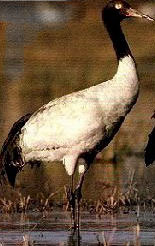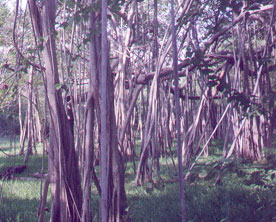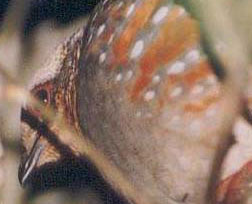Adventure
 'I believe any trip in search of wildlife can be coupled with physical activity and elements of cultural diversity to form a thrilling opportunity ' 'I believe any trip in search of wildlife can be coupled with physical activity and elements of cultural diversity to form a thrilling opportunity '
John H.Eickert
Some of you may know, 50 years ago this month, an ambitious Sherpa boy, and the gentle son of a New Zealand beekeeper became the first physical humans to summit the highest peak on Earth. Fewer will know, Everest was found to be the highest point from India!
An Indian geographer sitting in a small room and reviewing readings taken near Darjiling found Peak 15 to be the highest point on Earth. The year was 1852. The British were impressed with themselves, and renamed the mountain for a fine British gentleman who
never ever set foot anywhere near his mountain. The rest, as they say is history. No matter if you prefer the British name, the Tibetan, the Nepalese, or the Sanskrit the original trekking route to Chomolungma (Everest) began in Darjiling.
It is still possible to trek from Darjiling to Tumlingtar and the Khumbu retracing history. It is a long and exhaustive trek through the terai foothill country of Nepal. A shorter more practical route can take a trekker from Darjiling to Sandakphu. There are
a number of possible routes to a high point, which has great views of Chomolungma, Kanchendzonga, and Chomolhari in Bhutan. The best weather is in March and November. The mixed forest of rhododendron, oak, and pine is a bird lover’s bonanza. The magnolias
bloom in April and May. This is a good place to encounter cobra, watch your step. Two slithered across the track on different occasions on my tour. It is possible to see pigeons, falcons, thrushes, sunbirds, peafowl, flycatchers, minivets, and orioles. The
weather is warm and trekking not as rigorous as in Sikkim or Ladakh. This is a favorite trekking area for college students from lowland India, sharing the trail with them can be its own adventure. For the most part this is also the extent of the wildlife in
the area.
 Darjiling is still a wonderful hill town, famous for its tea and the terminus of the Darjiling Himalaya Railway. It is also the gateway for traveling into Sikkim. It is possible to encounter wild elephant and tiger near here, but such encounters are becoming
increasingly rare. Avoid this area during the monsoon. The storms blowing in from the Bay of Bengal last for months. The spring and fall are the best times for trekking. Darjiling is still a wonderful hill town, famous for its tea and the terminus of the Darjiling Himalaya Railway. It is also the gateway for traveling into Sikkim. It is possible to encounter wild elephant and tiger near here, but such encounters are becoming
increasingly rare. Avoid this area during the monsoon. The storms blowing in from the Bay of Bengal last for months. The spring and fall are the best times for trekking.
Next month we will trek in Sikkim an overview of the high altitude trek into Kanchendzonga base camp. Kanchendzonga is the third highest mountain on Earth and the trail to base camp is difficult. In the coming months I hope to encourage everyone to find a trek
to personal ability and go. There are a wide variety of treks available in India, something for everybody. India is a special country and deserves months of your attention WHEN you go. The great mountaineer, Reinhold Messner, said, “in life, it is not what
you have, it is what you have done.” I couldn’t agree more. Take the time and take your time. Happy hiking!
Visit
http://www.numbum.net or call NumBum Adventurers at 406-777-2228
|
Answers To Quiz Of The Month
Last month no one has given all right answers.
Right Answer to Coral Reefs
|
| 2.Why are coral reefs important to humans? |
|
they provide food |
they may contain valuable medicines
|
Both are correct
|
|
| 3.What is a big threat to coral reefs? |
|
global warming |
hurricanes |
Both are correct
|
|
| 4.Which of the following animals would you be likely to find in and near coral reefs? |
|
sharks |
octopus |
both the above
|
|
| 5.Coral reef mining is done for... |
|
Fishing |
Road construction |
Protein preparation
|
|
| 6.Where is the largest coral reef in the world located?
|
|
Off the coast of Andamans |
Off the coast of Bali |
Off te coast of Australia
|
|
| 7.Which of the following are harmful to coral reefs? |
|
oil spills from boats
|
dynamite fishing |
both the above
|
|
| 8.The main cause of coral reef bleaching is
|
|
fish eating the coral |
rapid changes in water temperature |
too many coral polyps
|
|
| 9.Riverborne silt topped by flyash from thermal plant caused deteriration in the coral reefs of |
|
Gulf of Mannar |
Hikkadaduwa and Bar Reef |
Inhaca Island Marine Reserve
|
|
| 10.Rani Jhansi Marine National Park is situated in |
|
Wandoor |
Jamnagar |
Andamans & Nicobar Island
|
|
Please try our quiz for the current month at
Trees
|
Endangered
Dr.Susan Sharma
 Of the 15 crane species in the world the Black necked crane (Grus nigricollis ) is one of the world's most threatened cranes. Discovered relatively recently in 1876, by the Russian naturalist / explorer, Count Prezhwalski,
this bird has an exclusive distributional breeding range between the altitudes of 3500 meters to 5500 meters in the tablelands of Central Asia. Its migratory patterns are equally unique. Cranes have been recorded from eastern Ladakh, southern Tibet, Bhutan,
Arunachal Pradesh to Szechwan, Yunan and vietnam Of the 15 crane species in the world the Black necked crane (Grus nigricollis ) is one of the world's most threatened cranes. Discovered relatively recently in 1876, by the Russian naturalist / explorer, Count Prezhwalski,
this bird has an exclusive distributional breeding range between the altitudes of 3500 meters to 5500 meters in the tablelands of Central Asia. Its migratory patterns are equally unique. Cranes have been recorded from eastern Ladakh, southern Tibet, Bhutan,
Arunachal Pradesh to Szechwan, Yunan and vietnam
Biologically, everything about the crane group, Gruidae, seems to indicate that the birds are of very old origin having appeared on earth some 60 million years before man. Now, probably, they are on their way out. They are not
found in abundance anywhere except in several Buddhist countries like Japan and Korea, where they receive socio-religious protection. Small groups of cranes do exist elsewhere in Asia, Europe, Africa, North America and Australia, but nowhere in South America,
the Malayan archipelago, Pacific Islands or New Zealand. Most species of cranes are migratory and some of them travel great distances each year. As for the black-necked crane, it chooses to migrate to higher altitudes to nest.
The cranes are famous for their spectacular and beautiful dances in which they bow, leap into air and toss vegetation about whilst uttering loud bugling calls.
Bhutan is an important wintering ground for the stately Black necked cranes,. Each year, Phobjikha valley plays host to more than 230 threatened cranes. They stay in the valley until around the first week of March foraging for
bamboo tuber, insects, grains etc.
|
Forest and trees
Compiled by Priti Sawant
Introduction
Man has been fascinated by nature since he evolved from his primitive ancestors, the apes. If there was anything on which he could depend with any confidence towards its availability, it was plants. Large number of plants provided
him with food, curative medicines and shelter.
In India trees and plants have been respected with devotion, have been affectionately fondled and almost treated as members of family. Large numbers of plants, considered sacred in India, are called the Bodhi trees, as certain
sages received enlightenment under them.
The conservation of plants by worshiping them was very likely an important factor in making them sacred.
To mention few instances, Kalidasa mentions kindly spirits like Vanadevatas (godly trees), who had been companions of Shakuntala in the forest, almost shedding tears when she left her sylvan home for her residence in the palace
of her husband, the king. When Sita abandoned by Laxmana in the forest at the command of Rama, Sita’s sorrow stirred the trees and plants and expressed their grief by shedding flowers like large drops of tears. Parvati makes no difference between her fond
son Kumara and a Devdaru (Deodar) sapling almost chosen as her pet offspring. In Vishnusahasranama ( a holy prayer book of Hindus which contains 1001 names of Lord Vishnu), Vishnu is mentioned as the very embodiment of imposing trees like Udumbara, (Ficus
glomerata) Asvattha ( Ficus religiosa), Asoka (Saraca asoka) and Nyagrodha( Ficus benghalensis).
Plants are repeatedly mentioned in connection with customs, traditions and beliefs. In fact, in India, no ceremony is complete without sacred plant being used.
 The worship of trees in India is understandable as the trees not only provided shade in the hot scorching summers, food, medicine and fuel but the forests meant rain which was essential for a purely agricultural economy. The trees being beneficial to humanity,
to protect them became a religion and were converted into the abode of tree spirits or vanadevatas. To cut down a tree meant depriving the spirit of its home and very often if it became imperative to cut down any tree, special prayers of forgiveness were performed
before a tree was cut down or another abode offered to the vanadevata. Invariably, it is not the trees that are worshiped but the spirit residing in them. Myths vary in different parts of India. The worship of trees in India is understandable as the trees not only provided shade in the hot scorching summers, food, medicine and fuel but the forests meant rain which was essential for a purely agricultural economy. The trees being beneficial to humanity,
to protect them became a religion and were converted into the abode of tree spirits or vanadevatas. To cut down a tree meant depriving the spirit of its home and very often if it became imperative to cut down any tree, special prayers of forgiveness were performed
before a tree was cut down or another abode offered to the vanadevata. Invariably, it is not the trees that are worshiped but the spirit residing in them. Myths vary in different parts of India.
Seldom has any culture been so deeply and consistently associated with plants and trees as that of Hinduism and Buddhism which are shared by India.
We start a new series under which you would be able to read stories about the indigenous trees/plants and their importance in Indian mythology and folklore. The list of such indigenous plants is infinite, yet some of the commonly
known trees/plants will be presented before you.
(Photo: Roots of a banyan tree by Susan Sharma)
|
News and Views
News…….
iwc@indianwildlifeclub.com
Elephant Story Contest
First, the long awaited elephant story contest results..Third prize goes to
Vinita Agrawal, from Indore. Second prize goes to
Suhas Kumar from Bhopal and the first prize goes to an unknown sender who sent in the contest entry without giving his/her email. Our database is not sophisticated enough to track down all the users who logged in.
But then, Vivek Menon of Wildlife Trust of India, has the final word on the winners and here they are. You can watch the clips with the captions by
clicking here.
Birds 7 ( B-7) -A play
Many of you who visit our website must have seen our page on NGOs. We have included ETF ( Experimental Theatre Foundation) as the second name in our NGO list, though they are not exactly wildlife or nature related. If you have
read through and also clicked on the link B-7, a play you will understand why. In a manner similar to us at IndianWildlifeClub.com, where we rely on the power of the internet to create awareness, Manjul Bharadwaj has been using the power of theatre to make
people aware about the need for environment conservation. Well ETF has again been chosen to represent India in the Buro Fur-Kultur Und Medien Projekte theatre festival in Germany. The quacking troup of B-7 is busy preparing to face international audiences.
To read this play online
click here.
The yahoo club has been involved in some healthy sharing of ideas. We have been receiving many e mails from members about volunteering opportunities in the field of wildlife. The following message posted on the yahoo club by Wildlife
Institute of India will be of interest to many.
CALL FOR VOLUNTEERS TO WORK IN WII'S LEOPARD ECOLOGY
PROJECT AT BORI AND SATPURA
We invite volunteers (Indian nationals only) for assisting the Wildlife Institute of India's Leopard
Ecology project working out of Churna in Bori Wild Life Sanctuary. The major role of the volunteers will
be to walk transects for the estimation of wild prey abundance and assist with other components of field
work which will include collection of scats and collection of large carnivore kill remains.
Ideally we will want the volunteers to be based in the field for a minimum period of 15 days at a stretch. We need volunteers immediately and the field season is till the onset of the monsoon in July. Ideally we want volunteers to come in groups of 2 to 3 people.
Volunteers need to reach Itarsi, the closest
railhead. We will be able to provide basic facilities for staying in the field and basic food. Expect hot field
conditions. The volunteers should come equipped with adequate field clothing and their personal medicinal needs. Interested people are requested to respond as soon as possible with a brief cv and a write up explaining why they want to volunteer and indicating
dates for which they propose to volunteer to Shri Qamar Qureshi at
qnq@wii.gov.in with a copy to Dr Ravi Chellam at
rchellam61@yahoo.co.uk
For those interested in tiger census, here are some helpful contacts supplied by Sandeep
You could contact Mr. Sambakumar at Wildlife Conservation Society
http://www.wcsindia.org
or
Mr. Praveen Bhargav at Wildlife First.
http://www.wildlifefirst.info/about.htm
'Wildlife Film Experience in India'
'Wildeye', UK is organizing 'Wildlife Film Experience in India' based in Corbett National Park, with places for 10 people for 12 days. The cost of this camp which will be held from 14-25 November 2003, is £1,350 per person. For
more details visit
http://www.wildeye.co.uk/india.html.
Views……..
(These views of K.S Ram of Van Dhan Mission, Bastar, Chattisgarh, appeared in the Times of India, Newspaper)
 " Mango is a major forest produce in Bastar. Provisions of Panchayat Act 1996 ( Extenson to Scheduled Areas) confers ownership status to tribals in respect of non-timber forest produce. Since the Bastar mango is of average quality only, the demand is for
cut mango pieces, amchoor. Bastar produces more than 4,000 metric tons of amchoor per annum. " Mango is a major forest produce in Bastar. Provisions of Panchayat Act 1996 ( Extenson to Scheduled Areas) confers ownership status to tribals in respect of non-timber forest produce. Since the Bastar mango is of average quality only, the demand is for
cut mango pieces, amchoor. Bastar produces more than 4,000 metric tons of amchoor per annum.
Two grades of amchoor sell in the market - black and white. Customers prefer the white to the black and so the black sells at only half the price. We wondered-the source of the mangoes being the same, how are some white and others black?
With help from the NDDB, we investigated this matter and found that the amchoor cut with iron knives turned black wheras the amchoor cut with steel remained white. A stainless steel knife cost Rs 10, and an iron knife only Rs2.
Using iron knoives, the tribals lost out on an income amounting to Rs 400 lakh per annum. The solution was simple- either replace iron with steel or dunk the amchoor in an anti-oxidant like lime water which is easily available in paan shops. "
|
Understand The Animals
 |
Yasser Arafat. "Watching wild life is my hobby from the beginning. Recently I completed MBA but not interested in that type of work. I wanted to do something for the
conservation of endangered wild animals and birds of Himalaya. I have started wild life photography and videography from last one year and have plenty of genuine knowledge of Pheasants and wild animals of Himalaya."
|
 To see wild animals and birds and to find out still unknown facts about them, this is my hobby. Going to the remotest part of a forest where no one has gone, is what I like doing best. I like trekking to these parts, climbing a difficult mountain, just
for the satisfaction of seeing a small shy bird and observing it without being seen by it. To see wild animals and birds and to find out still unknown facts about them, this is my hobby. Going to the remotest part of a forest where no one has gone, is what I like doing best. I like trekking to these parts, climbing a difficult mountain, just
for the satisfaction of seeing a small shy bird and observing it without being seen by it.
To recognize the sounds of different birds and animals, to know where they are found, and to ponder on why Mother Nature created them- questions keep coming to my mind and time flies.
I have been visiting jungles near my house ever since I can remember. Now my days are filled with trekking, photographing, capturing a movement on video.
When I first heard about the mountain blue quail, I decided to go in search of it. I have searched far and wide and in the process managed seeing many other interesting species around the 70-80 sq.km jungle where I live. I have
come to know their numbers, where they live, and how to locate them from the various sounds they make.
Almost every day, I wake up in the morning and go for a walk in the jungle. That is how I learnt to differentiate ground-nesting birds from the scratching sounds they make.
Black partridge and rufous-throated partridge are rarely found together. Their vocal sounds and scratching sounds are also distinct. I have never seen a black partridge scratching for food in the bushes. It keeps running between
bushes calling loudly to one another. Before the actual call it starts with a small note…CHWIK…..uttered two or three times before the loud TI-TITRI-TITRI….Rufous throated partridge on the other hand never comes out in the open except early morning when it
has to cross from one bush to another. It is not a fast runner unlike the black partridge. Mimicking the call of a rufous throated is easy, if you know how to whistle.
Another difference I noted was that the black partridge prefers to roost on the ground inside bushes, whereas the rufous throated prefers to roost on trees.
 Black partridge prefers the corner of a field, a big rock, and an old ruined house covered with bushes; he announces his presence by calling. Whereas the Rufous throated is rather quiet and mostly calls only upon getting disturbed
or specifically to a mate during breeding season. Its sound is a small whistle note…Phew-Phew-Phew… Black partridge prefers the corner of a field, a big rock, and an old ruined house covered with bushes; he announces his presence by calling. Whereas the Rufous throated is rather quiet and mostly calls only upon getting disturbed
or specifically to a mate during breeding season. Its sound is a small whistle note…Phew-Phew-Phew…
There are a number of commonalities between the two partridges. Both are comparable in flight. When disturbed both can do a good freezing act- Absolute stillness combined with camouflage colours, can make the partridge disappear
in no time.
I had a very interesting experience last year. I heard the call of a black partridge very close to my house. Curiously the first note CHWIK was absent in the call. Trying to locate the call I came upon a long tailed Shrike, happily
mimicking the partridge call. This bird incidentally is very good at mimicking others too. On one occasion I caught him mimicking a Khalij Pheasant. But the mimic sound is always less loud than the actual call, you can mistake it for the call of an immature
bird.
That is all for this month. More notings from my journal next month.
( Photographs of Rufous throated hill partridge in the wild are by Yasser Arafat)
|
Zoo
 Toby Ninan retired from Delhi Zoo about two years back. With his varied experiences with the wild animals in the zoo, he is the right person to direct your queries to. Hear what Ninan has to say about his life and chosen career! Toby Ninan retired from Delhi Zoo about two years back. With his varied experiences with the wild animals in the zoo, he is the right person to direct your queries to. Hear what Ninan has to say about his life and chosen career!
Lots of people have fear of snakes and I was no exception to this.
Parents and friends tell all sorts of stories and as a child these stories have very lasting effects on one. They have the habit of frightening the minds of impressionable youngsters.
Well, when I joined the Zoo, it had no serpentarium. I had no exposure to looking after snakes except to shooting the odd crawly that got into the monkey cages/their sleeping dens. Here they posed a threat
not only to the monkeys but also to the keepers who could and would get bitten by snakes. It was one of my responsibilities to see that no animal or keeper would get hurt. Thus I used to keep an old .22 bore rifle all oiled and cleaned up with a magazine ready
to knock out any snake that dared to come into the realm of the monkeys. This was one of those messy jobs that involved a lot of care and very good marksmanship. A bullet fired off the mark of the snake might easily ricochet and instead of the snake, the monkey
or yourself would end up in hospital with bullet wounds.
 This state of affairs had to come to an end soon. After I was appointed the curator in the Singapore Zoo I watched my assistants, who were mostly boys of 16-18 years of age, catching all sorts of snakes
with impunity. Here I was, 34 years of age, heading the curatorial side of a large zoo, not being able to catch a snake! I really felt very ashamed and resolved to learn the art. I started observing my keepers catching snakes very carefully. One day I got
my chance to catch a snake away from the peering eyes of others. This state of affairs had to come to an end soon. After I was appointed the curator in the Singapore Zoo I watched my assistants, who were mostly boys of 16-18 years of age, catching all sorts of snakes
with impunity. Here I was, 34 years of age, heading the curatorial side of a large zoo, not being able to catch a snake! I really felt very ashamed and resolved to learn the art. I started observing my keepers catching snakes very carefully. One day I got
my chance to catch a snake away from the peering eyes of others.
My wife used to throw household garbage in a large dustbin kept in the centre of our housing complex. There was secondary jungle right around the living quarters. There, right on the lid of the dustbin was
a snake all reared up to strike the lady. She screamed and dropped the garbage. I was watching from a distance and did exactly what one of my keepers would do. I took a rounded stick, about 2.5 ft in length and 2 inches in diameter and pinned the middle of
the snake down on to the top of the dustbin and keeping the pressure down rolled the stick slowly towards the head. When I managed pinning down the neck region, I grabbed the snake by the neck. As soon as I got a good grip I lifted the snake off the bin and
in a trice he twisted himself around my arm. The twisted snake was not at all uncomfortable; it only had the firmness of a hearty handshake!
I caught hold of the tail with the other hand and after uncoiling the coils on my hand I released the snake into the jungles nearby. The snake never made his appearance on that bin again. I believe he had
had enough and did not want to be partner to a wrestling match with me.
On my part, I lost my fear of snakes and never looked back. I have caught snakes galore since then- including an anaconda (where I nearly lost my life) and a huge cobra in the Prime Minister's residence.
But then these are other stories!
|